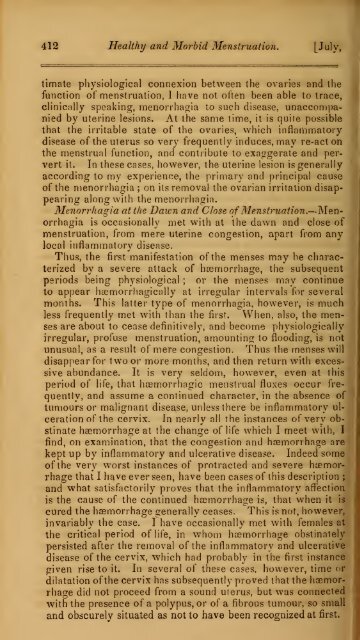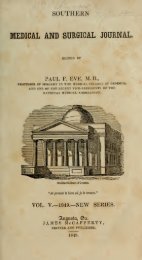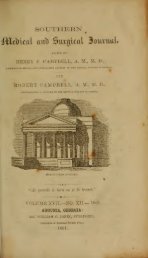Southern Medical and Surgical Journal - Georgia Regents University
Southern Medical and Surgical Journal - Georgia Regents University
Southern Medical and Surgical Journal - Georgia Regents University
You also want an ePaper? Increase the reach of your titles
YUMPU automatically turns print PDFs into web optimized ePapers that Google loves.
412 Healthy <strong>and</strong> Morbid Menstruation, [J^^y*limate physiological connexion between the ovaries <strong>and</strong> thefunction ot" menstruation, 1 have not often been able to trace,clinically speaking, menonhagia to such disease, unacconi))aniedby uterine lesions. At the same time, it is quite possiblethat the irritable state of the ovaries, which inflammatorydisease of theuierus so very frequently induces, may re-actonthe menstrual function, <strong>and</strong> contiibute to exaggerate <strong>and</strong> pervertit. In these cases, however, the uterine lesion is generallyaccording to my experience, the primary <strong>and</strong> principal causeof the nienorrhagia ; on its removal the ovarian irritation disappearingalong with the menorrhagia.Menorrhagia at the Dawn <strong>and</strong> Close of Mensti^uation.—Menorrhagiais occasionally met with at the dawn <strong>and</strong> close ofmenstruation, from mere uterine congestion, apart from anylocal inflammatory disease.Thus, the first manifestation of the menses may be characterizedby a severe attack of hcemorrhage, the subsequentperiods being physiological ; or the menses may continueto appear haemorrhagically at irregular intervals for severalmonths. This latter type of menorrhagia, however, is muchless frequently met with than the first. When, also, the mensesare about to cease definitively, <strong>and</strong> become physiologicallyirregular, profuse menstruation, amounting: to flooding, is notunusual, as a result of mere congestion. Thus the menses willdisapr>ear for two or more months, <strong>and</strong> then return with excessiveabundance. It is very seldom, however, even at thisperiod of life, that ha3m.orrhagic menstrual fluxes occur frequently,<strong>and</strong> assume a continued character, in the absence oftumours or malignant disease, unless there be inflammatory ulcerationof the cervix. In nearly all the instances of very obstinatehaemorrhage at the change of life which I meet with, Ifind, on examination, that the congestion <strong>and</strong> hcemorrhage arekept up by inflammatory <strong>and</strong> ulcerative disease. Indeed someof the very worst instances of protracted <strong>and</strong> severe hiemorrhagethat I have ever seen, have been cases of this description ;<strong>and</strong> what satisfactorily proves that the inflammatory affectionis the cause of the continued haemorrhage is, that when it iscured the haemorrhage generally ceases. This is not, however,invariably the case. I have occasionally met with females atthe critical period of life, in whom haemorrhage obstinatelypersisted after the removal of the inflammatory <strong>and</strong> ulcerativedisease of the cervix, which had probably in the first instancegiven rise to it. In several of these cases, however, time ordilatation of the cervix has subsequently proved that the haemorrhagedid not pi-oceed from a sound uterus, but was connectedwith the presence of a polypus, or of a fibrous tumour, so small<strong>and</strong> obscurely situated as not to have been recognized at first.








